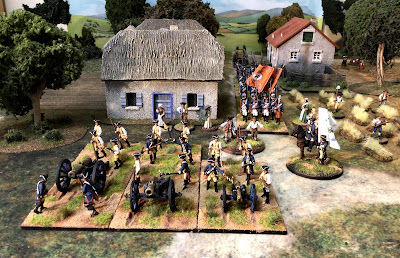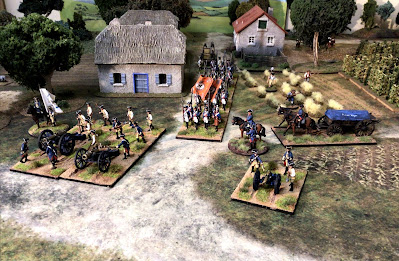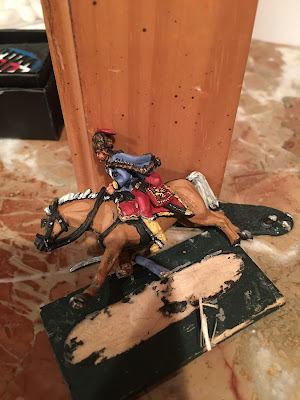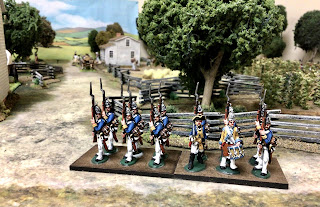 |
| Prussian artillery battery composed of seven cannon: two each of 12-pound Brummers, and 10-pound howitzers, and three regular 12-pounder guns. |
Click or Double Click on All Pictures to Expand the View
The past couple of weeks I have focused on building out my Austrian and Prussian artillery units so that each cannon model has its own munitions wagon and 4-horse limber team. I started with the additions to the Prussian artillery. Come on, did you really expect otherwise?
I confess that I borrowed this idea from Barry Hilton, as shown in his Revolution to Empire set of rules wherein he did the same for one of his Napoleonic artillery batteries. The idea is that there would have been a significant area behind the cannon that was filled with equipment such as munitions wagons, repair workers, limber teams, and a beehive of activity from all of the support crew carrying munitions from the wagons to the actual cannon. The laborers, who moved the guns so that they could be resited by the professional artillery crew, are also depicted immediately behind the cannon models.
 |
| Side view of the Prussian artillery battery gives one a sense of how deep the area of an artillery deployment is what with all of the supporting equipment. |
 |
| Another side view of the artillery battery. |
My cannon models are not glued or otherwise attached to the bases, which allows me to pick and choose the types of cannon that I want to use in a particular game. For example, the giant 12-pound Brummer fortress guns were not used in very many battles (think Leuthen for a notable example of their use in a battle) so I might want to use the regular Prussian 12-pounders in my game, or some of the 6-pounders or 10-pound howitzers. Fredick seemed to especially like his howitzers so there should be a couple used in every game.
The artillery battery vignette shown in these pictures features Minden Miniatures Prussian artillerymen and the generic pioneers in waistcoats, used as the mattrosses, or laborers. The cannon models are all from the Fife and Drum Miniatures artillery selections in the catalog.
The limbers are a mix of Fife and Drum Y-shaped limbers as well as some of the more expensive limber models from Berliner Zinnfiguren. The limber horses are a mix of RSM standing limber horses and Minden walking horses. The munitions wagons are from Front Rank Miniatures and Fife and Drum Miniatures. The pictures give you a sense of how nicely everything fits together.
I like how this looks. What do you think?
Your comments and questions would be most welcomed in the comment section at the bottom of this blog thread.
I still need to paint three more munitions wagons to complete the Prussian artillery park and then I will start working on the Austrian equivalent.
Some war gamers will view the need for limbers and wagons as an uneccessary addition and expense, but the effort really pays off. One doesn't have to use 4-horse limber teams, two horses will look just as nice. In fact, I use 2-horse teams for the munitions wagons due largely to the fact that I can't fit the wagon and four horses onto the 60mm by 120mm bases that I use for ammo wagons. I also use the same size bases for my limbers and cannons. The laborers are mounted on a 60mm by 40mm base. You will note that all of my artillery/component bases are 60mm wide so that everything lines up neat and tidy when deployed or on the move.
When I limber up and move the guns, the gun is hooked onto the back of the limber, followed by the gun crew stand, followed by the laborer stand and the munitions wagon. When the gun is ready to unlimber and deploy, then the gun is placed back on its stand, backed up by the laborers, the munitions wagon, and finally the limber team.
I also have some extra repair vignettes such as a field forge, a gun with a broken wheel, and an artillery "gin" (a device with a pulley that is used to lift the heavy gun barrel off of the gun carriage in the event that the carriage needs to be replaced and repaired).
The field forge would be used to repair iron work on the equipment or to reshoe horse shoes for the limber horses. These vignettes are not placed with the gun battery, but rather, further behind the lines back at the camp. They look particularly nice and add to the overall look of one's table top.





















